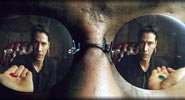 January turned out to be a very busy month with trips that took me from coast to coast.
January turned out to be a very busy month with trips that took me from coast to coast.
I launched four projects that had been planned in 2009 with the strategic impact to hit this year.
- The Repeatable Successful Acts (RSA) platform continues to gain traction with clients looking to make impactful changes to their sales processes. Changes that are simple and powerful. The RSA platform provides a wide variety of choices that can be applied in a customized manner without completely restructuring an existing system. Think simple, powerful and elegant for a strong strategy.
 Many companies from Apple to Zappos continue to focus on the TOTAL client experience to create separation from the commoditized competition. My approach to the idea is an adaptation of one of the RSAs – I PERFORM TO ONE LEVEL ABOVE EXPECTATIONS. I refer to this as OLA or One Level Above. In order to change your customer experience you need to know what the current experience is. We provide a facilitated method of creating an “experience map”, a tool that provides the current reality of your existing client experience . The client experience is a great place to create differentiation as it is one of the few aspects of market leadership you CAN control.
Many companies from Apple to Zappos continue to focus on the TOTAL client experience to create separation from the commoditized competition. My approach to the idea is an adaptation of one of the RSAs – I PERFORM TO ONE LEVEL ABOVE EXPECTATIONS. I refer to this as OLA or One Level Above. In order to change your customer experience you need to know what the current experience is. We provide a facilitated method of creating an “experience map”, a tool that provides the current reality of your existing client experience . The client experience is a great place to create differentiation as it is one of the few aspects of market leadership you CAN control. Education continues to drive the SKILL SET STRATEGY. Improving your team’s skills is another strategy of control. In a world of instant change, market control becomes an illusion. You can control how good you are at what you do. My clients are focusing on communication and thinking skills. The goal is to create a knowledge base that can gain traction through great communication.
Education continues to drive the SKILL SET STRATEGY. Improving your team’s skills is another strategy of control. In a world of instant change, market control becomes an illusion. You can control how good you are at what you do. My clients are focusing on communication and thinking skills. The goal is to create a knowledge base that can gain traction through great communication.
February is my month to work on internal Creative Ventures projects such as my web site restructuring, filming a series of internal videos and looking at my core business structure for new ways to maximize my idea base. Of course, I remain impacted by the somewhat random nature of my calendar.
“Strength is the matter of the made up mind” — John Beecher
We live in a multiple choice world. Think about it for everything from cookies to cars we have more choices than any time in history. Take a walk down the toothpaste aisle at Wal-Mart and check out the inventory of multicolor packages. These huge arrays of choices are both a blessing and a curse. They impact our decision making process.
 During a recent meeting with clients we were discussing a strategy that had turned into a problem. After listening to them describe the deteriorating aspect of their issue, I asked them to explain to me the decisions that brought them to this point. There was a long pause and I could tell the team didn’t know what I meant. I changed my attack plan and simply asked them to describe their decision making process. Again a long silence. The bottom line, they had no real decision making process, no method or application of thinking that guided their decisions.
During a recent meeting with clients we were discussing a strategy that had turned into a problem. After listening to them describe the deteriorating aspect of their issue, I asked them to explain to me the decisions that brought them to this point. There was a long pause and I could tell the team didn’t know what I meant. I changed my attack plan and simply asked them to describe their decision making process. Again a long silence. The bottom line, they had no real decision making process, no method or application of thinking that guided their decisions.
Think that’s unusual? Nope. Pull your team together and ask them for their decision making process. Ask them to articulate how they make decisions. See if they can give you a logical sequence of taking thought to action.
The funny thing is, we are decision making machines. We do it all the time, both with our use of thought-out choices and also with our gut feeling. We change lanes in our car without thinking, but we choose our movies by a thoughtful approach.
Our approach to business decision making is often reckless or haphazard. Think of the times you really followed a “thinking process” when approaching a decision. I’m not talking about pepperoni or sausage, I’m talking about reducing the workforce, expanding into a new market, adding services, or changing a training program. You know, the big stuff.
The process of making a decision falls under two very general categories:
 Intuitive: This happens at the subconscious level and is often referred to as “your gut feeling”. Don’t ignore this emotional tool. This is a powerful decision making apparatus, but is best when leveraged with data.
Intuitive: This happens at the subconscious level and is often referred to as “your gut feeling”. Don’t ignore this emotional tool. This is a powerful decision making apparatus, but is best when leveraged with data.- Rational: From Plato to Benjamin Franklin to Carl Sagan – all used a strong rational model for making decisions. Think of the old “pro and con” list. A simple process of listing advantages and disadvantage, of thinking about the options that reside within each decision.
The key is committing to a defined way of thinking about choices. Think of it as an exercise in “framing”. How do you build a framework around decision making and how to do you make sure your team engages in that process?
 In the movie, The Matrix, the character is given a defining decision to make, framed by two choices – taking the red pill or taking the blue pill. One provides the truth, a new and unknown reality, and the other keeps things as they are. It is a classic issue of choice. Neo, the character at the center of this decision frames it with what he knows. He stops, slows down to decide and then, when he makes the decision, shows no hesitation taking the pill of choice. Neo uses both the intuitive model and the rational model, combined in a very short time frame to make his decision.
In the movie, The Matrix, the character is given a defining decision to make, framed by two choices – taking the red pill or taking the blue pill. One provides the truth, a new and unknown reality, and the other keeps things as they are. It is a classic issue of choice. Neo, the character at the center of this decision frames it with what he knows. He stops, slows down to decide and then, when he makes the decision, shows no hesitation taking the pill of choice. Neo uses both the intuitive model and the rational model, combined in a very short time frame to make his decision.
With the intuitive and rational models in play, why do people still struggle with making a decision? One of the barriers is The Myth of 100%, the mistaken idea that every decision we make must always be totally correct. Forget about that. In fact, most decisions have a natural fault line making it impossible for them to be perfect. You don’t need perfect, you need “mostly right”.
Here is a simple three part formula. It will ENCOURAGE decision making. It will guide you and your team to “mostly right”. It can be monitored and used both individually and collectively.

DEFINE / DECIDE: I include these two as a single point because during the defining step, you are often deciding at the same time. It is the combined intuitive process with the rational part. Make sure the issue requiring a decision is well defined and with that definition a decision is clear.
ACTION: Yep, the old hurdle of doing. Remember, you don’t have to be 100% correct. You can take action with the knowledge you almost always need to be mostly correct. Do not allow the vast ocean of fear paralyze you from doing. If you truly did Step 1 you have already put in the right thinking to allow you to “pull the trigger.”
ASSESS: The crew of the Apollo 11 moon mission was only on their predetermined course 2.5% of the time. They were assessing and adjusting 97.5% of the time. Make sure you are tracking and flexing around within your decisions. Adjust to make key course corrections.
There you go, the classic three part Creative Ventures model. Try it; give it to your team. MAKE SOMETHING HAPPEN, by becoming a great decision maker.

The Client Experience: One of the defining trends impacting business in 2010 is a refocus on every aspect of how a client experiences their dealings with you and your business. CitiCorp, through their innovation lab is redefining the retail banking experience. By a three part focus (sound familiar?): attraction, engagement and connection they have developed multifunctional ATM’s, interactive store displays, table top kiosks and high definition media walls. All are changing the “client experience”. They should be ready to roll later this year.
 The Simpsons Turn 20: Homer and crew form the longest continuous show, drama or comedy in prime time television history. Here are a few numbers from Springfield:
The Simpsons Turn 20: Homer and crew form the longest continuous show, drama or comedy in prime time television history. Here are a few numbers from Springfield:
- It costs more than $500,000 to animate each episode.
- Last year companies spent more than $314.8 million on advertising.
- Over 500 companies license the Simpsons brand.
- The Simpsons universe contains more than 300 characters.
Not bad for a group of orange skinned, four fingered jokesters.
 Mattel Makes Toys Win, But . . . Toy maker Mattel has had a good few quarters. Earnings increased from .49 cents a share a year ago to .89 cents the last quarter. Sales grew on a strong demand for Hot Wheels and Barbie dolls. Now Barbie was first introduced in 1959 and Hot Wheels cars in 1968. This is the first time in 2 years that either brand has shown an increase in sales. Strong brands often defy time. Now for the “but’ part. Despite beating Wall Street analyst’s predictions by .13 a share, their stock dropped 1%! Hey, what’s a toy got to do to get some respect!
Mattel Makes Toys Win, But . . . Toy maker Mattel has had a good few quarters. Earnings increased from .49 cents a share a year ago to .89 cents the last quarter. Sales grew on a strong demand for Hot Wheels and Barbie dolls. Now Barbie was first introduced in 1959 and Hot Wheels cars in 1968. This is the first time in 2 years that either brand has shown an increase in sales. Strong brands often defy time. Now for the “but’ part. Despite beating Wall Street analyst’s predictions by .13 a share, their stock dropped 1%! Hey, what’s a toy got to do to get some respect!
Interested in these ideas?
FOLLOW STEVE ON TWITTER.COM —
CREATIVEVENTURE
FOLLOW STEVE ON FACEBOOK.COM —
STEPHEN HARVILL
You can contact Steve at steve@creativeventures.com or give him a call at 972-490-7717.
See more at creativeventures.com and stephenharvill.com
 January turned out to be a very busy month with trips that took me from coast to coast.
January turned out to be a very busy month with trips that took me from coast to coast. Many companies from Apple to Zappos continue to focus on the TOTAL client experience to create separation from the commoditized competition. My approach to the idea is an adaptation of one of the RSAs – I PERFORM TO ONE LEVEL ABOVE EXPECTATIONS. I refer to this as OLA or One Level Above. In order to change your customer experience you need to know what the current experience is. We provide a facilitated method of creating an “experience map”, a tool that provides the current reality of your existing client experience . The client experience is a great place to create differentiation as it is one of the few aspects of market leadership you CAN control.
Many companies from Apple to Zappos continue to focus on the TOTAL client experience to create separation from the commoditized competition. My approach to the idea is an adaptation of one of the RSAs – I PERFORM TO ONE LEVEL ABOVE EXPECTATIONS. I refer to this as OLA or One Level Above. In order to change your customer experience you need to know what the current experience is. We provide a facilitated method of creating an “experience map”, a tool that provides the current reality of your existing client experience . The client experience is a great place to create differentiation as it is one of the few aspects of market leadership you CAN control. Education continues to drive the SKILL SET STRATEGY. Improving your team’s skills is another strategy of control. In a world of instant change, market control becomes an illusion. You can control how good you are at what you do. My clients are focusing on communication and thinking skills. The goal is to create a knowledge base that can gain traction through great communication.
Education continues to drive the SKILL SET STRATEGY. Improving your team’s skills is another strategy of control. In a world of instant change, market control becomes an illusion. You can control how good you are at what you do. My clients are focusing on communication and thinking skills. The goal is to create a knowledge base that can gain traction through great communication.


 During a recent meeting with clients we were discussing a strategy that had turned into a problem. After listening to them describe the deteriorating aspect of their issue, I asked them to explain to me the decisions that brought them to this point. There was a long pause and I could tell the team didn’t know what I meant. I changed my attack plan and simply asked them to describe their decision making process. Again a long silence. The bottom line, they had no real decision making process, no method or application of thinking that guided their decisions.
During a recent meeting with clients we were discussing a strategy that had turned into a problem. After listening to them describe the deteriorating aspect of their issue, I asked them to explain to me the decisions that brought them to this point. There was a long pause and I could tell the team didn’t know what I meant. I changed my attack plan and simply asked them to describe their decision making process. Again a long silence. The bottom line, they had no real decision making process, no method or application of thinking that guided their decisions.
 In the movie,
In the movie, 


 The Simpsons Turn 20:
The Simpsons Turn 20: